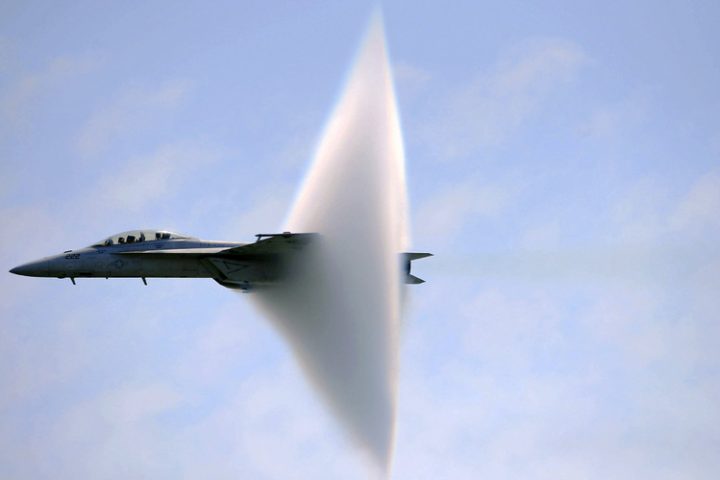Sonic Booms
By David Ren 任大偉

While few of us have personally heard one, many of us have witnessed a sonic boom’s shockwave surrounding a speeding fighter jet or a bullet. Known in popular culture as a loud boom that occurs when an object exceeds the speed of sound, sonic booms are of great interest to aircraft designers and a source of ire for residents near airports. Producing a sonic boom was once thought impossible as numerous attempts to penetrate the sound barrier led to broken fuselages and wings [1].
A sonic boom is akin to skipping stones on a pond. Stone skipping produces ripples on the pond’s surface. The speed at which ripples spread through the water is determined by the intermolecular bonds and the surface tension of the water. This is because the bonds determine the maximum rate at which a water molecule can move when surrounded by other water molecules. When these effects are combined, the maximum speed at which molecules can collide is known as the speed of sound in that medium. Colloquially of course, the speed of sound refers to the maximum speed of molecular collisions in air.
A jet travelling through air produces similar ripples that are elongated further behind as the jet accelerates. If the jet were travelling at the speed of sound locally, the air propagates these ripples as quickly as the jet is flying. Imagine standing in front of a plane as it accelerates towards the sound barrier. Initially, the engine noises can be heard from a great distance. When the jet reaches the speed of sound and beyond, it can no longer be heard from any observer in front of the plane. That is, until the sonic boom catches up.
The loud boom is the result of a buildup of air molecules that can no longer travel faster than the plane. This pressure disturbance is called a Mach wave and is the cause of sonic booms. This means that a sonic boom is not a one-off event. As the plane travels, it drags the cumulative air molecules in the vicinity so a person positioned beneath its path would hear the boom. In other words, if one were to follow a plane that was travelling at the speed of sound, one would constantly hear sonic booms.
The famous sonic boom “cloud” that surrounds an aircraft is a physical manifestation of the “breaking” of the sound barrier. However, the cloud is a separate phenomenon to sonic booms. The vapour cone is due to flow-induced vaporization [2].
When a jet exceeds the speed of sound, the air flowing over the fuselage is suddenly compressed due to the effects previously described. When the air pressure, temperature, and density fall below the dew point, an effect called Prandtl-Meyer expansion increases the air pressure, temperature, and density to create a shock wave. If the air humidity is sufficiently high, water condensation will occur with the low pressure of the expansion wave that then dies at the second shock wave to create a vapour cone [3].
Sonic booms are not isolated to jets and bullets. The same principles are present when objects travel through water. If a boat travels faster than the speed of sound in water, one easily visualizes a Mach cone, the fluid mechanical cone that accompanies sonic booms. “Sonic” booms or shockwaves are also possible with light. If light could travel faster than the speed of light in that medium, one could create a “photonic” boom. This is better known as Cherenkov radiation. When nuclear reactors are activated, one sees a blue and ultraviolet glow due to charged particles speeding faster than photons in that medium [4].
Sonic booms are mesmerizing phenomena that captured imaginations. When early pilots believed that the sound barrier was a physical force that broke planes, they could not envisage Concorde whisking passengers from London to New York for 3hrs, 30 minutes at Mach 2. The study of sonic booms is crucial in making flights more comfortable for both passengers and those who live in its Mach carpet (people who can hear a plane’s sonic booms).
References
[1] Heussner, K. M., Supersonic Speed Demons: Breaking the Sound Barrier. Retrieved from http://abcnews.go.com/Technology/AheadoftheCurve/supersonic-speed-demons-breaking-sound-barrier/story?id=8716157
[2] Campbell, J. F., Chambers, J. R. Patterns in the Sky – Natural Visualization of Aircraft Flow Fields. (1994) Retrieved from http://ntrs.nasa.gov/archive/nasa/casi.ntrs.nasa.gov/19950024579.pdf
[3] Prandtl-Meyer Angle, NASA. Retrieved from https://www.grc.nasa.gov/www/k-12/airplane/pranmyer.html
[4] Color Effects Near the Speed of Light – Cerenkov Radiation. Retrieved from http://www.webexhibits.org/causesofcolor/4BA.html
[5] Concorde F.A.Q. Retrieved from http://www.concordesst.com/faq.html